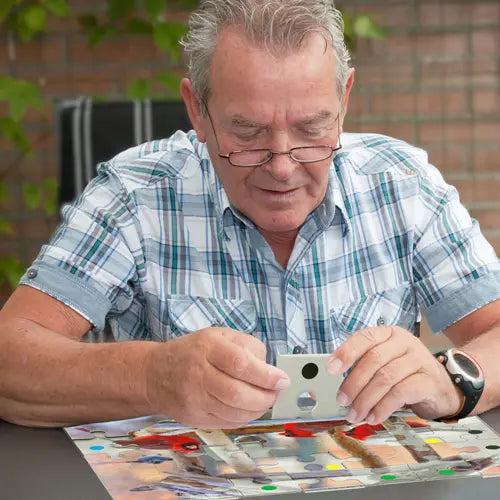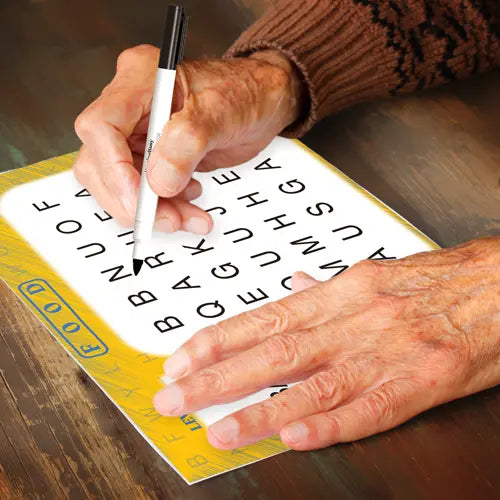
Choosing an activity for a person with dementia is not easy. Dementia activities not only have to be of interest to them, the person must also be able to do them successfully. Even though they may have had a hobby that they loved, just throwing them into the middle of it likely won't work. Rather, it will be frustrating for them because they realize that they can no longer do it. They could easily be disinterested and even get angry. It is important for their self-esteem that they are able to participate in the activity and experience a sense of accomplishment.
It is also very beneficial if the same dementia care activity can be used in more than one way, and at more than one skill level. When the activity is first presented, it can be used in its simpler form until the person can do it successfully. Once that has been achieved the activity can be turned into something more challenging, but the familiarity is there so it is not seen as threatening.
As abilities decline, this same activity can once again be used in a simpler form. Because it is already familiar, it is easier to get success and give your loved one a feeling of accomplishment. This adjustment according to ability is called "vertical programming" and is one of the characteristics of Montessori activities for people with dementia.
THINGS TO CONSIDER
- It is of interest to the person
- It is something they are familiar with
- It matches their abilities
- It accomplishes the goals
- It can be broken down into manageable steps
An example of a good activity that offers these benefits is the tangram. The tangram is an old Chinese puzzle consisting of seven pieces that together make a square. The pieces can be put together in literally hundreds of ways to make different recognizable shapes. This allows you to present the activity at the same level while keeping it interesting because of the variety of shapes. This is called "horizontal programming" and is another characteristic of Montessori activities for dementia patients.
We have taken the traditional tangram and created templates for shapes. On one side of the template the outline of each piece that makes up the shape is shown, on the other side, there is only the outline of the overall shape. When starting the side showing the complete shapes is used so that it familiarizes the person with the whole concept and makes it easier to complete successfully. Once the activity is understood and success has been achieved, the more difficult side can be used where only the outline is shown, making it much more difficult to complete.
So how do you go about choosing an activity? The first criteria is that the activity is of interest, or can be turned into something of interest. Just as you would not suddenly decide that woodworking is for you if you have never show an interest in it, your client would not either. However, if someone could show you how fun it is, maybe you would like to give it a try.
The easiest starting point is to choose a hobby or activity that was of interest in the past and find a way to make it achievable. Step back and take a fresh look at it. What aspect of the hobby was most enjoyable to them? Is there a way to break out that portion of the activity? Do they have the ability to do it, or some form of it? For example, a woodworker may enjoy hand sanding a nice piece of wood or a wooden project. A handyman may enjoy assembling something simple. Start with an easy project that can be done relatively quickly, then make it more complex as the person becomes more familiar with it and achieves some success.
Often an activity can be overwhelming because the person is no longer able to anticipate the steps involved to get from the start to the finish. Break the activity down into manageable steps so that they can be completed individually. This is referred to as "sequencing" and allows success to be achieved at each step along the way instead of having to complete a larger project before gaining a sense of accomplishment.
For example, if the person enjoyed baking, choose a foolproof recipe, ideally one that brings back good memories and encourages discussion. Break the recipe into separate, simple steps. Present each step as a separate activity than can be completed successfully leading to the final product.
Another important consideration in choosing an activity is to decide what you want to accomplish with the activity. Are you trying to improve mobility? Increase strength? Improve cognitive skills? Or are you simply looking for something to keep the person from being bored? If you have a particular goal in mind then not only does the activity have to be of interest, it has to have some aspect that meets the goal. Most activities help in more than one way. For example, the domino activity described below helps with cognitive ability and also helps with dexterity. Generally it is best to have several activities available, each of which helps in a different area. This is part of the Montessori way.
Here are some specific ideas and suggestions that you can use as a starting point. Remember that if the activity is not interesting to the person then it won't be successful, and if they can't do the activity then it will only lead to frustration. These activities use items that you may already have in your cupboard, or can easily obtain. They are likely familiar and may provide opportunities for reminiscing.
In our store we offer many of these as pre-packaged demen tia activities that have been carefully designed to maximize the benefits in accordance with the Montessori principles. Each dementia specific activity comes with comprehensive instructions not only describing how to use the activity, but also on how to present it for the first time and how to tailor its use to get the best results based on the needs, interests and abilities of the person. Instructions also provide information on adapting the activity as these change.
JIG SAW PUZZLES (SEE OUR JIGSAW PUZZLES FOR DEMENTIA)
- Choose an image that has interest for the person to make it appealing and to help lead to conversation about the topic
- Make sure that the image is such that parts of it can easily be identified so that pieces can be picked out more easily (for example, don't pick an image with a solid blue sky, pick one with individual clouds that can be identified on the pieces)
- Make sure pieces are big enough for person to handle
- Make sure that there are not too many pieces
DOMINOES
- Use only a small set - if you already have a large set (double 12 for example), pick out the tiles to make it double 4 (15 tiles)
- Once proficiency is gained, move up to double 6 (28 tiles)
- As abilities decline, go back to double 4
- A simple game is to "deal" some of the dominoes, lay one down then take turns placing tiles that match one of the numbers
PLAYING CARDS
- Cards should be easy to handle (not sticky or slippery) and have easy to read and identify suits and numbers
- Use cards as a sorting activity - by suit, by number, in order, by suit and order - show them an example and have them match
- Use smaller subset of deck to make it easier, add cards as proficiency increases
- People with more abilities can enjoy games that they are familiar with such as Cribbage or Gin Rummy with support and emphasis on having fun not strategy and winning
- Simpler games include such things as Crazy Eights, War or Elimination
- Play the most challenging game that the person can do well at
BOOKS/MAGAZINES (SEE OUR DEMENTIA READERS)
- Topics of interest but not childish
- Print large enough that person can read it easily
- Make sure that book or magazine is easy to hold
- Let person read it themselves, have them read it out loud, take turns reading out loud
- Pick magazines that have lots of pictures that can lead to discussion
DICE
- Make up games that involve adding numbers or matching patterns
- Make sure person rolls the dice and picks them up as part of the game - good for dexterity
WORD PUZZLES (SEE OUR WORD PUZZLES FOR DEMENTIA)
- Simple word searches with no diagonals or backward words
- Large print
- Few enough squares to be appropriate but still challenging - move up as proficiency increases, move down as abilities decline




